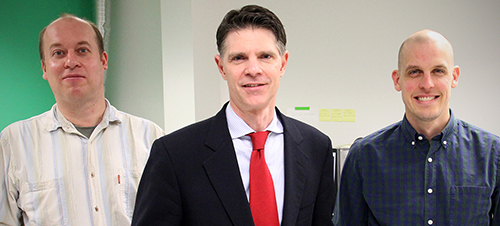Congress Holds Off on Enabling FDA Regulation of Clinical Laboratory-Developed Tests
Supporters of the VALID Act say lobbying blitz by academic medical centers prevented its passage
In 2022, a bill before Congress titled the Verifying Accurate Leading-Edge IVCT Development Act (VALID Act) sought to change the current regulatory scheme for clinical laboratory-developed tests (LDTs) and in vitro clinical tests (IVCTs).
But even though the College of American Pathologists (CAP) and nine other organizations signed a December 12 stakeholder letter to leaders of key House and Senate committees urging passage of legislation that would enable some regulation of LDTs, the VALID Act was ultimately omitted from the year-end omnibus spending bill (H.R. 2617).
That may be due to pressure from organizations representing clinical laboratories and pathologists which lobbied hard against the bill.
The American Association for Clinical Chemistry (AACC), American Society for Clinical Pathology (ASCP), Association for Molecular Pathology (AMP), Association for Pathology Informatics, and Association of Pathology Chairs were among many signatories on a May 22 letter to leaders of the US Senate Committee on Health, Education, Labor and Pensions that described the bill as “very flawed, problematic legislation.”
The Association of American Medical Colleges (AAMC) also signed the letter, as did numerous medical laboratories and health systems, as well as the American Society of Hematology and the Clinical Immunology Society.

Responding to criticism of its stance on FDA oversight of LDTs, in a May 2022 open letter posted on the organization’s website, anatomic pathologist and CAP president Emily Volk, MD, said “we at the CAP have an honest difference of opinion with some other respected laboratory organizations. … We believe the VALID Act is the only viable piece of legislation addressing the LDT issue. … the VALID Act contains many provisions that are similar to policy the CAP has advocated for regarding the regulation of laboratory tests since 2009. Importantly, the current version includes explicit protections for pathologists and our ability to practice medicine without infringement from the Food and Drug Administration (FDA).” (Photo copyright: College of American Pathologists.)
Organizations on Both Sides Brought Pressure to Bear on Legislators
“University laboratories and their representatives in Washington put on a full-court press against this,” Rep. Larry Bucshon, MD, (R-Indiana) told ProPublica. Bucshon, who is also a cardiothoracic surgeon, co-sponsored the VALID Act along with Rep. Diana DeGette (D-Colorado).
The AAMC and AMP were especially influential, Bucshon told ProPublica. In addition to spending hefty sums on lobbying, AMP urged its members to contact legislators directly and provided talking points, ProPublica reported.
“The academic medical centers and big medical centers are in every state,” Bucshon said. As major employers in many locales, they have “a pretty big voice,” he added.
CAP, on the other hand, was joined in its efforts by AdvaMed, a trade association for medical technology companies, the American Cancer Society Cancer Action Network, Association for Clinical Oncology (ASCO), Association of Black Cardiologists, Friends of Cancer Research, Heart Valve Voice US, LUNGevity Foundation, and The Pew Charitable Trusts.
Discussing CAP’s reasoning behind its support of the VALID Act in a May 26 open letter and podcast, CAP president Emily Volk, MD, said the Valid Act “creates a risk-based system of oversight utilizing three tiers—low, moderate and high risk—in order to target the attention of the FDA oversight.”
While acknowledging that it had room for improvement, she lauded the bill’s three-tier risk-based system, in which tests deemed to have the greatest risks would receive the highest level of scrutiny.
She also noted that the bill exempts existing LDTs from an FDA premarket review “unless there is a safety concern for patients.” It would also exempt “low-volume tests, modified tests, manual interpretation tests, and humanitarian tests,” she wrote.
In addition, the bill would “direct the FDA not to create regulations that are duplicative of regulation under CLIA,” she noted, and “would require the FDA to conduct public hearings on LDT oversight.”
Pros and Cons of the VALID Act
One concern raised by opponents relates to how the VALID Act addressed user fees paid by clinical laboratories to fund FDA compliance activities. But Volk wrote that any specific fees “would need to be approved by Congress in a future FDA user fee authorization bill after years of public input.”
During the May 2022 podcast, Volk also cast CAP’s support as a matter of recognizing political realities.
“We understand that support for FDA oversight of laboratory-developed tests or IVCTs is present on both sides of the aisle and in both houses of Congress,” she said. “In fact, it enjoys wide support among very influential patient advocacy groups.” These groups “are very sophisticated in their understanding of the issues with laboratory-developed tests, and they do have the ear of Congress. There are many in the laboratory community that believe the VALID Act goes too far, but I can tell you that many of these patient groups don’t believe it goes far enough and are actively pushing for even more restrictive paradigms.”
Also urging passage of the bill were former FDA commissioners Scott Gottlieb, MD, and Mark B. McClellan, MD, PhD. In a Dec. 5 opinion piece for STAT, they noted that “diagnostic technologies have undergone considerable advances in recent decades, owing to innovation in fields like genomics, proteomics, and data science.” However, they wrote, laws governing FDA oversight “have not kept pace,” placing the agency in a position of regulating tests based on where they are made—in a medical laboratory or by a manufacturer—instead of their “distinctive complexity or potential risks.”
In their May 22 letter, opponents of the legislation outlined broad areas of concern. They contended that it would create “an onerous and complex system that would radically alter the way that laboratory testing is regulated to the detriment of patient care.” And even though existing tests would be largely exempted from oversight, “the utility of these tests would diminish over time as the VALID Act puts overly restrictive constraints on how they can be modified.”
CLIA Regulation of LDTs also Under Scrutiny
The provision to avoid duplication with the Clinical Laboratory Improvement Amendments (CLIA) program—which currently has some regulatory oversight of LDTs and IVCTs—is “insufficient,” opponents added, “especially when other aspects of the legislation call for requirements and activities that lead to duplicative and unnecessary regulatory burden.”
Opponents to the VALID Act also argued that the definitions of high-, medium-, and low-risk test categories lacked clarity, stating that “the newly created definition of moderate risk appears to overlap with the definition of high risk.”
The opponents also took issue with the degree of discretion that the bill grants to the US Secretary of Health and Human Services. This will create “an unpredictable regulatory process and ambiguities in the significance of the policy,” they wrote, while urging the Senate committee to “narrow the discretion so that stakeholders may better evaluate and understand the implications of this legislation.”
Decades ago, clinical laboratory researchers were allowed to develop assays in tandem with clinicians that were intended to provide accurate diagnoses, earlier detection of disease, and help guide selection of therapies. Since the 1990s, however, an industry of investor-funded laboratory companies have brought proprietary LDTs to the national market. Many recognize that this falls outside the government’s original intent for encouragement of laboratory-developed tests to begin with.
—Stephen Beale
Related Information:
The Tests Are Vital. But Congress Decided That Regulation Is Not.
Message from the CAP President on the VALID Act
Better Lab Test Standards Can Ensure Precision Medicine Is Truly Precise
Healthcare Groups Urge Congress to Pass Diagnostic Testing Reform Before Year’s End
Califf: FDA May Use Rulemaking for Diagnostics Reform If VALID Isn’t Passed
Is FDA LDT Surveillance Set to Improve as VALID Act Heads to Resolution?
Congress Needs to Update FDA’s Ability to Regulate Diagnostic Tests, Cosmetics
FDA User Fee Reauthorization: Contextualizing the VALID Act
They Trusted Their Prenatal Test. They Didn’t Know the Industry Is an Unregulated “Wild West.”
InsideHealthPolicy: Pew, AdvaMed, Others Push for VALID as Clock Ticks on Government Funding
AdvaMed Leads Letter Urging Lawmakers to Support Bipartisan Diagnostics Reform




